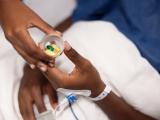A study today in the Canadian Medical Association Journal (CMAJ) shows a significant drop of Clostridium difficile infection (CDI) in Canadian hospitals.
The results of the multicenter study, which looked at data from acute care hospitals across Canada, found that the national rate of healthcare-associated CDI fell from 5.9 to 4.3 per 10,000 patient-days from 2009 through 2015, a 27% reduction in cases. That included a substantial reduction in the prevalence of NAP1 (North American pulsed-field gel electrophoresis type 1), a virulent strain of C difficile that causes more severe illness and death than other strains of the pathogen.
NAP1, which is characterized by higher than usual levels of toxin A and B and high-level resistance to fluoroquinolone antibiotics, is associated with rising rates of healthcare-associated CDI in both the United States and Canada. The rise in CDI cases in Canada began in 2002, with a series of CDI outbreaks in hospitals in Quebec. Research on those outbreaks found that NAP1 was the culprit.
Downward trend, changing epidemiology
To examine how the epidemiology of healthcare-associated CDI has evolved in Canada in the wake of those outbreaks, researchers with the Canadian Nosocomial Infection Surveillance Program—a network of acute care hospitals in 10 Canadian provinces—looked at data on 20,623 cases of healthcare-associated CDI reported by adult-only and mixed participating hospitals from 2009 through 2015. Microbiologic data, including molecular typing and antibiotic susceptibility test results, were available for 2,690 of these patients.
While the national rate of CDI initially rose at the beginning of the 7-year study period, peaking at 6.7 cases per 10,000 patient-days in 2011, the overall trend was downward, with the rate of cases falling to 4.3 in 2015. Similar trends were noted Canada's western and central provinces, while the rate of cases in eastern Canada remained lower than the national average.
The overall reduction of healthcare-related CDI dropped 27% for the entire study period and 36% since 2011, when cases peaked, through 2015.
Results of molecular typing revealed that NAP1 (37.6%) was the most prevalent strain of C difficile, followed by NAP4 (14.2%) and NAP11 (5.9%). But over the 7-year period, the molecular epidemiology of CDI cases changed, with NAP1 decreasing by 40%, while NAP4 strains doubled and NAP11 strains saw a sevenfold increase.
The decrease in NAP1 is an important trend, because NAP1 strains, when compared with all other CDI strains, were found to have a higher death rate (15.6% vs. 10.6%) and a higher death rate attributable to CDI (6.6% vs. 2.9%). NAP1 strains were particularly deadly in patients aged 75 to 84 years, resulting in a death rate of 19.3%, compared with 12.3% for other strains. Multivariable analysis revealed that patients infected with an NAP1 strain were nearly twice as likely to die from CDI as patients with other strains.
The researchers also found that, for every 10% increase in the proportion of NAP1 strains submitted by the individual hospitals, the rate of healthcare-associated CDI rose by 3.3%.
"Our findings suggest that, as the proportion of NAP1 strain isolates decreases in relation to all circulating strains, both the rate of health care–associated C. difficile infection and the number of severe cases can be expected to decrease relative to a peer hospital with a higher proportion of NAP1 circulating isolates," Kevin Katz, MD, medical director of infection prevention and control at North York General Hospital in Toronto, said in a CMAJ press release.
Post-outbreak improvements
Katz and his colleagues suggest the national reduction in CDI could be attributable to infection-control and quality-improvement measures that were instituted after the outbreaks occurred. These measures include improved diagnostic techniques, antibiotic stewardship (most notably reduced fluoroquinolone use), improved hand hygiene, and better, more frequent environmental cleaning.
A similar decrease in NAP1 prevalence, along with a rise in other strains, has been observed in recent reports from the United States and the United Kingdom.
C difficile is a bacterium that causes inflammation of the colon and severe diarrhea. Although it is a natural part of the gut microbiome, infections commonly occur in healthcare settings among older patients being treated with antibiotics, which can wipe out the bacteria that help keep C difficile in check. CDI is a leading cause of diarrhea in hospital patients and one of the most common healthcare-associated infections.
See also:
Jun 25 CMAJ study
Jun 25 CMAJ press release






















